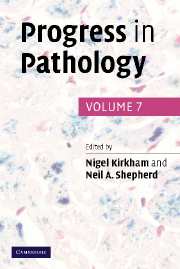Book contents
- Frontmatter
- Contents
- List of Contributors
- Preface
- 1 The microbiological investigation of sudden unexpected death in infancy
- 2 An overview of childhood lymphomas
- 3 Assessment of the brain in the hospital consented autopsy
- 4 The value of immunohistochemistry as a diagnostic aid in gynaecological pathology
- 5 The role of the pathologist in the diagnosis of cardiomyopathy: a personal view
- 6 Metastatic adenocarcinoma of unknown origin
- 7 Immune responses to tumours: current concepts and applications
- 8 Post-mortem imaging – an update
- 9 Understanding the Human Tissue Act 2004
- 10 The Multidisciplinary Team (MDT) meeting and the role of pathology
- 11 Drug induced liver injury
- Index
- References
2 - An overview of childhood lymphomas
Published online by Cambridge University Press: 06 January 2010
- Frontmatter
- Contents
- List of Contributors
- Preface
- 1 The microbiological investigation of sudden unexpected death in infancy
- 2 An overview of childhood lymphomas
- 3 Assessment of the brain in the hospital consented autopsy
- 4 The value of immunohistochemistry as a diagnostic aid in gynaecological pathology
- 5 The role of the pathologist in the diagnosis of cardiomyopathy: a personal view
- 6 Metastatic adenocarcinoma of unknown origin
- 7 Immune responses to tumours: current concepts and applications
- 8 Post-mortem imaging – an update
- 9 Understanding the Human Tissue Act 2004
- 10 The Multidisciplinary Team (MDT) meeting and the role of pathology
- 11 Drug induced liver injury
- Index
- References
Summary
INTRODUCTION
Lymphomas encompass a diverse group of neoplasms that arise from the clonal proliferation of lymphoid precursor cells. They are triggered by a series of genetic events that may be related to genetic predispositions, viral and other environmental factors, or may simply be accidental genetic rearrangements.
Lymphomas are the third most common cancer in children in the UK, behind acute leukaemias and brain tumours. They account for approximately 11–13% of all childhood malignancies with an annual incidence of 13.2 per million children [1]–[4]. The age-specific incidence rates and clinical features of paediatric lymphomas in white children in the USA correspond to those in Europe [5]. In equatorial Africa, 50% of all childhood cancers are due to lymphomas, because of the high incidence of Burkitt's lymphoma.
Paediatric lymphomas can be classified into Hodgkin's lymphoma (HL) and non-Hodgkin's lymphoma (NHL). The main subtypes are defined in the REAL classification [6], but the more recent WHO classification updates and expands this [7]. NHLs represent 60–70% of all childhood lymphomas in developed countries [2], [8], affecting children mainly between 7 and 10 years of age. The male-to-female ratio recorded in a Dutch study was 2.5 [5]. There is, however, an increased incidence in children with inherited or acquired immunodeficiencies [9], [10]. HL represents the remaining 30–40% of childhood lymphomas. Their incidence increases steadily throughout life and studies show a male-to-female ratio of 2.7 [5].
Unlike adult NHLs, which are often low-to-intermediate grade, the paediatric NHLs are frequently high-grade lymphomas and are clinically aggressive.
- Type
- Chapter
- Information
- Progress in Pathology , pp. 15 - 48Publisher: Cambridge University PressPrint publication year: 2007

